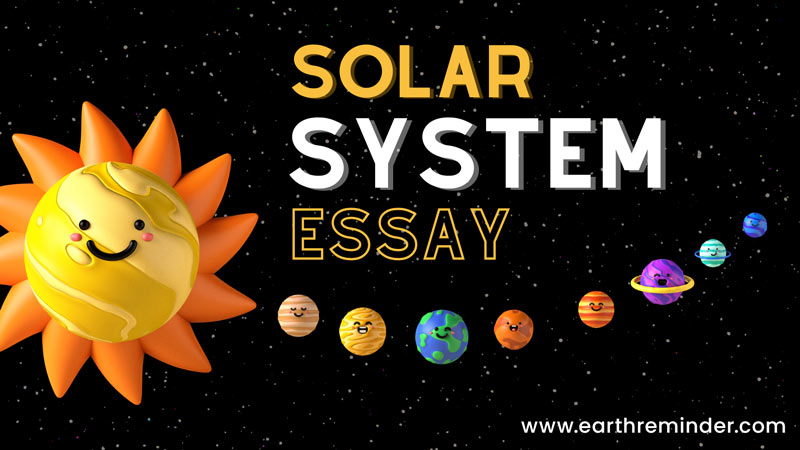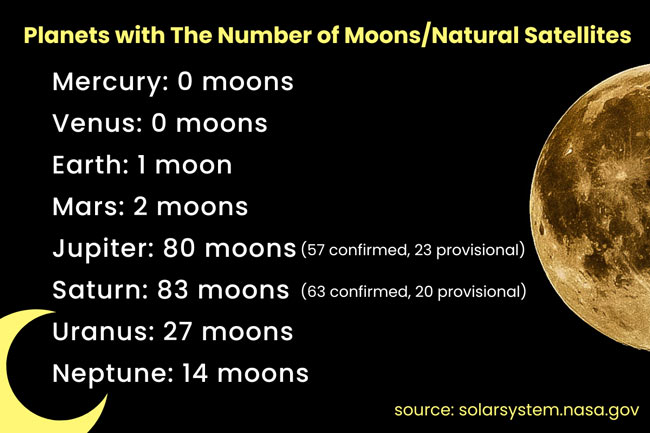Introduction: Essay on Solar System for Kids
The first poem we learned was ‘Twinkle Twinkle little star, how I wonder what you are!’ Isn’t it? Also, there are numerous poems dedicated to the ‘Moon’ and its beauty. Do you know the reason? It’s because everyone loves to see a beautiful view of the night sky with all those stars and a pretty moon, especially for small kids. Their young brain is fascinated by all those objects which are shiny and have some mystery associated with them. To enhance their interest in learning and to groom the minds of young budding scientists and astronauts, this solar system essay will help kids to get their basic understanding of the universe, galaxy, solar system, planets, satellites, and a lot more.
During the day, we find it hard to look up at the sky because of a yellowish ball hanging in the sky. This ball is known as the Sun. It is the source of light and energy for all living beings. When it comes to the night sky, we can all see a whitish ball, which changes its shape every night. This ball is called the Moon. Along with the Moon, there are many tiny glittering and twinkling dots in the sky at night. These dots are called Stars.
All of these uncountable stars, the sun, and moon are part of the Universe. Now we should learn more about what is a Universe, galaxies, and the solar system in this essay.
Table of Contents
What Are the Universe, Galaxy, And Solar System?
The universe is everything that does exist including the Sun, Moon, all the stars, planets, meteoroids, stardust, small particles, and everything that exists in free space. No one can determine how big the universe is. It is assumed to be of infinite space and is still in the process of expanding or we can say becoming larger and larger. It is said to be 13-14 billion years old.
The term galaxy is given to a gigantic collection of millions and billions of stars along with their solar systems, different gases, and dust, all held together by the force of gravity. The galaxy to which we belong is called the Milky Way Galaxy. All the stars we see during the night belong to our Milky Way Galaxy. There are an estimated 100- 200 billion galaxies in the universe.
A star has some gravity associated with it, which makes it attract a few planets, dust, and small objects that revolve around it. The star with the objects revolving around it makes a solar system. In simple words, a solar system can be defined as a collection of planets, their moons, a few asteroids, comets, dust, and gas that orbit a central star. Our solar system has the Sun as the central star and our planet Earth along with other planets (8 in total) revolves around the sun because of its gravity. Let us read more about our solar system.
Our Solar System Essay
As we have discussed earlier that our solar system consists of the sun and its eight planets, so the name of these planets in the ascending order of distance from the sun are Mercury, Venus, Earth, Mars, Jupiter, Saturn, Uranus, and Neptune. The planets which are nearer to the sun are comparatively smaller than those which are far away. We should discuss these planets in brief.
MERCURY
It is the closest planet to the sun. Mercury is also the smallest and fastest planet in our solar system. It is named after the angel (messenger) of the Gods of the Roman Empire. Its surface is made of craters, valleys, and mountains. It does not have any atmosphere and hence it’s assumed that life is not possible on Mercury. It experiences an extreme temperature difference of 800°F in the daytime and -290°F at night.
VENUS
It is the second closest to the Sun and is the hottest planet in our solar system. Venus was also named as the morning star and the evening star and derives its original name from the Roman Goddess of Love. The average temperature on Venus is 880°F. There are a lot of huge volcanoes and rivers of lava that flow across the planet. Its surface is almost entirely covered with clouds and is hard and rocky consisting of mountains and valleys.
EARTH
Our home planet Earth is the third planet from the sun. When looked upon from outer space, the earth seems like a bluish ball with bits of white clouds and brown-green land. The blue color comes from the water bodies that cover the major portion (70%) of the planet. It has an accurate distance from the sun (for the right temperature), water, oxygen, and atmosphere (nitrogen and other gases) which gives it the ability to sustain life.
MARS
It is the fourth planet from the sun and is also called the red planet. The red color comes from the iron present in the soil. The atmosphere on Mars is thinner compared to the Earth. It has a lot of volcanoes but they are dead. It is always suspected of the presence of aliens living on it and scientists have found traces of water on Mars.
JUPITER
It is the largest planet in our solar system. Jupiter is named after the king of the Roman Gods. It is a gas giant. It is also referred to as the failed star as it’s made of mostly hydrogen and helium but is not massive enough to start burning like a star.
SATURN
It is the sixth planet from the sun and is named after the Roman God of Architecture. Saturn is also a gas giant like Jupiter and is made of Hydrogen and Helium. It has a set of rings made of pieces of ice and rocks. Its atmosphere is thick. It is the second largest planet in our solar system. And it has the lowest density of all planets. Scientists say that Saturn is lighter than water and if placed in water, the planet will float. It is also nicknamed the ringed planet.
URANUS
It is an ice giant. Water, ammonia fluids, and methane contribute to the making of Uranus. It has a thick atmosphere made of hydrogen, helium, and methane. Methane makes the planet look blue. It has the coldest atmosphere of all planets in the solar system. It has faint rings.
NEPTUNE
It is named after the Roman God of the sea. It is also an ice giant like Uranus. Because of their similar appearances and features, Uranus and Neptune are called sisters.
Apart from the planets and the sun, there are some other heavenly bodies in the solar system. We shall discuss them as well.
SATELLITES: The term satellite is given to an object that revolves around a planet (larger object). The satellites which are naturally present for revolving around a planet are called their moons.
ASTEROIDS: They are also termed minor planets present in the solar system. Their size ranges from 1 meter to that of a dwarf planet (1000km) in diameter.
METEOROID: It is also known as space rock. Their size range extends from a dust particle to that of an asteroid. When they enter the earth’s atmosphere and burn, then they are termed shooting stars.
COMETS: They are objects which orbit around the sun and are made of frozen gases, dust, and rock.
Also Check: Unique Space Posters and Quotes Images For Children Inspiration.
Conclusion of Solar System Essay
There’s so much to learn about the solar system and its planets! The purpose of this solar system essay is to inspire your child to learn more about our magnificent universe. The more they study our solar system, the more fun facts they’ll discover. Someday, perhaps they’ll even become astronauts and see it all for themselves.
Now we have good knowledge about our solar system and we are aware of the fact that Earth is the only planet sustaining life. So, it becomes our duty to save our planet from all possible disasters and carry forward the existence of life in our solar system.

